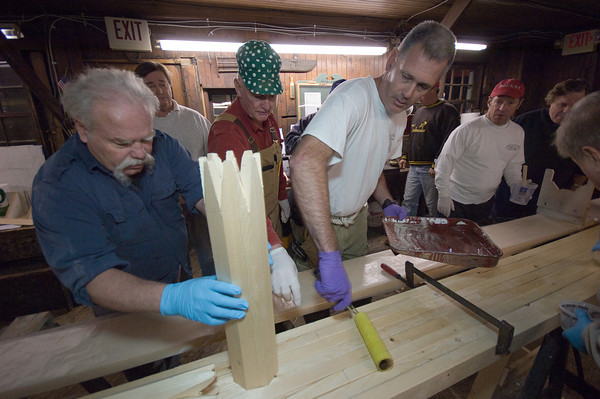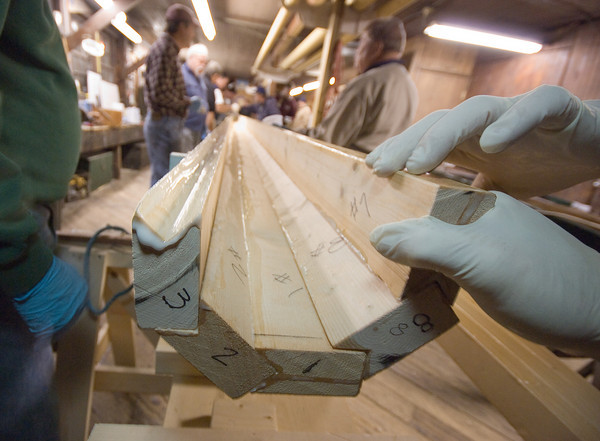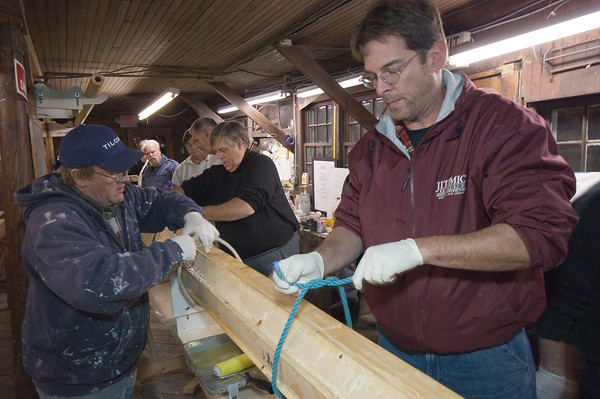
Wood is a truly wonderful material, not just for its beauty, but also for its excellent engineering characteristics. While wood technology has been around for thousands of years for boat construction purposes, wood technology is still developing today.
In August of 1999, Woodenboat magazine published an article on a novel type of wooden mast construction. Masts originally were tree trunks. Tree trunks themselves are very efficient engineering structures, but for many centuries it has been known that a hollow tree is not much weaker than a solid tree. Similarly a hollow mast also is not much weaker than a solid mast and much lighter. And in sailboat design light is good and light weight high in the boat is awesome.
Therefore hollow masts were a feature of the fanciest wooden sailboats for many years, and with epoxy glues it became possible to glue together fancy hollow masts and hollow wooden masts were quite common. But still, not until the 1999 Woodenboat article did the boatbuilding world become aware of a very clever approach to hollow mast building that is now generally referred to as bird’s mouth mast construction.

If you look at the crosssection of the mast the term is obvious since it looks like a bunch of bird’s beaks biting their neighbors.
I have tried to figure out who first thought of this method, but have not been successful and hopefully somebody who reads this can enlighten me, but by all indications the method is recent in nature.
I no longer own that issue of Woodenboat magazine, but remember thinking how much sense it made and wondering why it had taken so long for the method to be “invented”. But since it made such good sense, it became very rapidly accepted and, today, I would estimate that a majority of round larger wooden masts are constructed this way. (While round masts are not the most aerodynamic, they are structurally the most stable, and building a hollow unstayed non elliptical cross section wooden mast would be an engineering nightmare…… or at best a very expensive engineering tour de force)
The debut of the Rocket made me think about bird’s mouth masts again, because the new Rocket has a bird’s mouth mast. The construction of the Rocket’s mast was beautifully photographed byJeff Smith Photography, http://NJPhoto.Net and here I show some additional photos that should describe the process pretty well.




In looking at the sequence it can be seen the mast is glued up out of 8 wooden staves that have a simple 90 degree notch at one side. The mast is actually tapered and this can be easily accomplished by tapering the staves.
The notch is actually quite easy to cut with two passes on a table saw and if you want a straight mast with a perfect circular cross section, one only has to make sure that all eight staves are identical. The staves can be made out of scarfed pieces of wood without any trouble as long as the scrarfs are staggered in location along the mast length.
The Rocket mast is a stayed mast that is gaff rigged which means there are some additional load points and the Rocket team decided to reinforce those points with solid inserts. Those inserts were carefully shaped and dryfitted to fit on the first try when the mast is glued.
Once the eight staves have been cut and the filler pieces fit perfectly, the only scary step is the glueing of the mast.
And this is where the fun comes in, because the whole mast needs to come together before the glue starts to set. The Rocket mast was 38 feet long and smearing all that glue and fitting the whole thing together is a daunting task to say the least. If the glue were to kick before the assembly is done you end up with quite a pile of very expensive fire wood.
The glueing all comes down to planning, some practice, and lots of hands. The pictures show the planning and the hands. Planning even involves how the glue is spread; the staves are bundled and the epoxy is simply poured into the bird’s mouth grooves and spread out. Spreading out is important in epoxy, since epoxy sets exothermically, and when mixed epoxy is left in a pot it will overheat. Once it is spread out there is more relative surface area for the heat to escape and the cure time is extended.
Next the many hands come in when the staves are assembled in the form. Half of the pieces are laid down and then the filler pieces are laid down. Next the upper staves are pushed into place and then the whole thing is squeezed tight. Squeezing a round shape evenly with ropes or straps simply results in a tighter round shape without deformation and therefore one does not need to worry about slipping or sliding of the staves.
Once the squeeze is on (and with epoxy the squeeze pressure does not have to be very high) one can go to the extremely satisfying task of watching glue dry. Watching glue dry without proper hydration may be hazardous to the crew’s health and this is why the planning stage includes the proper staging of cold beer for the glue crew (glue crue?) during the cure period.

The shaping of the mast is a remarkably easy and natural task and then it becomes a matter of selecting the most obsessive crew member to apply twelve or so coats of fine varnish.
The result is a beautiful light weight and stable mast that would have been difficult to construct before this method was developed.
It has many subtle advantages over other methods that may not be immediately apparent but become glaringly obvious once the construction takes place.
One can build very large masts and the only restriction is the size of the assembly crew. However, only two experienced wood workers are required and the rest of the assembly crew can entirely consists of reasonably sober novices who are willing to practice one night and to attend for assembly the next night.
All the preparation work and finish work can be accomplished by the two skilled ship carpenters.
Other mast construction methods tend to generate a lot of waste, but this method instead allows the builder to invest in high quality wood with very little waste. Even wood with an occasional knot can be used since knots can be cut out of the staves and the staves can be rescarfed. Today that is a very significant consideration. In the old days, hollow mast were created by removing material from a few large wooden blanks, but to build a top quality mast it would be necessary to find the most perfect blanks and even in the old days that was far from easy.

On a pure engineering level there is a very interesting consideration in the optimal selection of the number of staves in a mast. If a mast is made of two staves and one stave has a flaw, the mast will almost certainly fail. Four staves is better in case there is a flaw in one of the staves, but eight staves sits somewhere in a magical range where structural redundancy of wood in a mast is just about optimal. The determination of the actual optimal number of staves might very well be a PhD engineering dissertation, but right here I am betting a mast building crew’s cold beer supply that more than eight staves may actually result in a reduction in the mast’s actual reliability and that eight staves is actually optimal.
Could it be that we have achieved an optimal approach in round mast wood technology? Nah, something even cleverer will undoubtedly come along.

